|
|
 The
VigilanceVoice The
VigilanceVoice
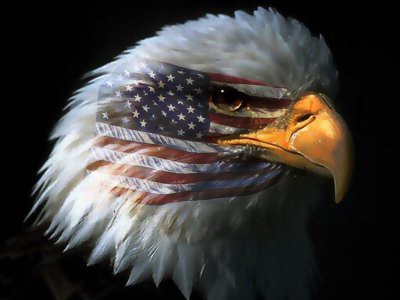
VigilanceVoice.com
Monday-- February 25, 2002—Ground
Zero Plus 167
Blood On The Totem Pole
A Lesson in Vigilance
Communication
by
Cliff McKenzie
Editor, New York City Combat Correspondent News
GROUND ZERO, New York City,
Feb. 24--I stabbed myself last yesterday. It was a deep, painful
wound. Blood spilled upon my totem pole, mixing with the raw nature
of the wood shavings, saturating into the grain, mixing mortality with
immortality.
I knew I was going to stab myself.
The day before I thought:
"Really good wood carvers must cut themselves occasionally. If
I'm really good, I will eventually become a "brother of the blood and
wood."
It isn't as though I planned on cutting
myself, or purposely designed it. Instead, it was like the ice
skater who knows to achieve excellence in learning new routines he or she
must be prepared to fall, must be able to withstand the rock-hard ice
slamming against his or her body when the execution of the move is not
perfect.
Or, like when I used to sail a
sailboat in Mission Bay. My friend who owned the other half of
the boat, Mike Kotlan, had sailed across the North Atlantic on a small
craft. He reminded me you weren't a real sailor until your boat had
tipped over and you learned how to right it.
Life, lived properly, is about
learning from our mistakes. One cannot push the envelope of the self
and evolve without risk, without peering over the edge and walking on the
thin ice of new achievements, new adventures.
There is little return unless there
is greater risk than the investment.
Wood carving is about weaponry.
I started out using sharpened
screwdrivers. They were crude but they dug at the wood, exposing the
vision I had under it. I had never carved wood before, but
always admired the craft, the art of it. Shaping something from
nothing seemed alluring to me.
As a writer I knew I could create anything
with words. I knew the magic of creation, and the hard work of
uncovering and discovering the magic of words. I make
thousands of mistakes in writing on the first draft. Long
sentences, confusing thoughts, misspellings, improper tenses fill the
page. Then I start to carve. Once the rough wood
of the words are formed, I take a red pen and slice at the copy, routing
out the confusion, digging at the run-on sentences, chiseling away the
passive Voice with bright, active verbs that brings what I have to say
to clear focus, and makes it alive.
Then I go over it again and again,
refining, polishing, sometimes re-cutting, reshaping what I said to make it
even clearer than before. Often, I put what I write
aside and in a couple of days look at it afresh, imagining myself a reader
not the writer, trying to cast away my ego and becoming a critic so I can slice and cut any waste, quicken the pace, sharpen the
images.
Even when I am finished, it is unfinished.
There is no perfection, there is only satisfaction that I have done the
best possible job--that it is ready for viewing, even with its imperfect
perfection. Then I publish it to an editor or a reader, and
wait for the final word that is good or bad, marketable or unmarketable in
that person's eyes. That's when a writer bleeds. I bleed waiting for acceptance.
Carving is similar. Except the
bleeding comes in the editing of the wood. It comes when I forgot to be Vigilant.
I had purchased some new
carving tools. Two chisels from the Ace Hardware
store. 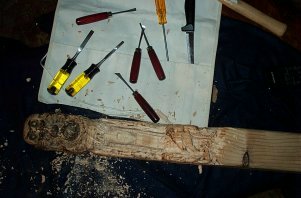 They
were good for roughing out the wood, but the fine work, the
real carving of intricate hands or angles to reflect light seemed
beyond the scope of the chisel. I went to New York Art
Supply on 3rd Avenue, packed with real and would-be artists
of all sizes and shapes. I was looking for
more and better carving tools. They presented
me with a giant box filled with them. I was a kid in a
candy store. I bought one of each, scoopers, routers,
knife blades, groovers. I was elated. They
were good for roughing out the wood, but the fine work, the
real carving of intricate hands or angles to reflect light seemed
beyond the scope of the chisel. I went to New York Art
Supply on 3rd Avenue, packed with real and would-be artists
of all sizes and shapes. I was looking for
more and better carving tools. They presented
me with a giant box filled with them. I was a kid in a
candy store. I bought one of each, scoopers, routers,
knife blades, groovers. I was elated. 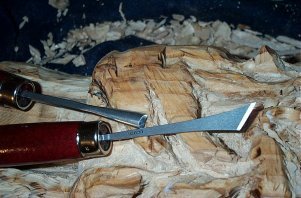
I rushed home and began to work on the
hands of the totem. I had been to New York's famous Museum of
Natural History and taken many photos of totems and carvings from around
the world and studied them so I could apply the principles my mentors had
left for guys like me to try and replicate in our crude way. I
called them Sentinels of the Wood. They were there to remove
my fear and intimidation that I wasn't worthy of carving, to urge me take
the chisel to the wood, to risk growing as they had when they first
chipped their first carving. I felt the complacency
washing away as I went from hall to hall in the museum, studying,
photographing, even standing on the benches to get closer views of the
shapes of hands, or how the carvers had created angles that caught the
light and made the image more realistic.
There was just one flaw in my training--no one
spoke from the statues and carvings. No one told me how to keep
myself safe. No one warned me about the errant gouging tool
that would slip off the hard wood as I rushed to dig out the wood and
spear into the palm of my hand, burrowing deep in the meat of my flesh,
cutting so close to a tendon that I felt the pain curl my toes. I
didn't notice the 'veterans of carving display' with severed fingers and
dried pools of blood - but I did observe most of the totems were red in
color.
Vigilance is learned lots of ways.
Had I taken a lesson in "how not to stab yourself" I might have escaped
the deep and gripping wound in my left hand. I learned the
hard way.
 Art of any form requires patience. When you
hurry, you rush Nature. And Mother Nature cannot be rushed. She works
at her own speed. Art of any form requires patience. When you
hurry, you rush Nature. And Mother Nature cannot be rushed. She works
at her own speed.
Working with children is a prime example.
First, you have to kneel down to their level when you communicate.
That's hard for most people to begin with. Most parents stand
when they communicate with a child, forgetting they impose upon the child
this giant wall of authority, this Gestapo figure who wags fingers and has
giant hands that can whack the bottom or, worse, injure the child with its
Goliath frame.
Kneeling down to eye level with a child is
the first step of Vigilance when communicating with them. Walt
Disney taught me that. He built Disneyland from the eyelevel
of a child. If you walk down Main Street as an adult, you see
the things an adult sees. But the engineers didn't build the
buildings from that viewpoint. Instead, Walt had his engineers kneel
down and make all their perspectives from that of a child's eyes.
If you want to see Disneyland as it really is, duck walk through it.
You'll see another world.
On the same level with a child, you
create a world of safety between yourself and the youth. The fear,
intimidation and complacency of your adultness melts. The child and
you are now on equal levels, and the odds are you and the child will
communicate as one. You can build trust with the child at his or her
level, and the child will tell you things from its heart and its innocence
with greater revelation than if you're standing.
Nature forces good things to happen
with patience. When I talk with my grandkids, I try to get
down to their level, and not have them "look up" at me. I want
to look at them. And they at me. We equalize ourselves that
way. I say "look in to my eyes, look at me."
Impatience destroys communications.
If I'm in a hurry and talk from my six-foot four-inch vantage point, I'm
just a tower to a child, something so far out of reach that the child
can't imagine being equal with me, being honest. And, at that
distance, neither can I. For standing, I cannot see the child's
world, I cannot enter it.
 |
|
CHUPACABRA |
Like an adult in a rush with a child, I didn't get down at eye
level with my wood. I was rushing, in a hurry to
expose the hands of the Chupacabra I was carving.
I jammed and shoved my tools at the wood, muscling all two-hundred
and seventy pounds of myself to route out a curve of the creature's
hand.
I was excited.
I had my left hand holding the wood and my weight forward, shoving
the thin, sharp routing tool as hard as I could in the groove
of chips when it slipped. Like an arrow, it shot over
the wood, glancing up and into the meat of my hand with great
force. I clamped my jaws, my toes curled, my face
turned white. Blood dripped onto the wood as I extracted
the shaft from hand. Throbbing pain hammered to
my brain.
I sat there saying
nothing for a few seconds, realizing that I had forgotten Vigilance.
That in my mad rush to unearth the wood, to make my "prize"
I hadn't respected the art of patience. I had become
complacent, invincible. The goal of ending my creation
became more powerful than the art of creating it.
I forgot to work with the wood, and had worked against it.
I had intimidated the wood with force and speed and it refuted
my speed and anxiety by rejecting my pressure.
"You Okay," my
wife asked. "Yeah, just made a mistake and
stabbed myself."
I put some ice on it and
wrapped it up, and went back to carving.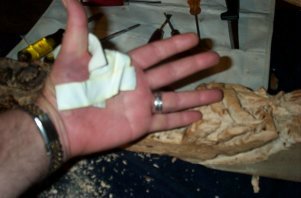 The ice numbed the pain. I come from the old school
where when the horse bucks you off you climb back on it and
ride again, to show the horse you're not afraid and to face
your fears. This time I used the tool with
respect, with patience, and even though drops of red oozed down
my hand from the ice, it felt good. I was learning
a lesson in wood carving Vigilance.
The ice numbed the pain. I come from the old school
where when the horse bucks you off you climb back on it and
ride again, to show the horse you're not afraid and to face
your fears. This time I used the tool with
respect, with patience, and even though drops of red oozed down
my hand from the ice, it felt good. I was learning
a lesson in wood carving Vigilance.
Once the ice had numbed
my hand I poured hydrogen peroxide on the wound and my
wife wrapped it for me. She was concerned I would get my blood
on the totem. She suggested I should wear a glove on my
left hand, the one I used to hold the wood was I carved.
I got a thick glove and put it on. It was my Shield
of Vigilance. I felt much safer now.
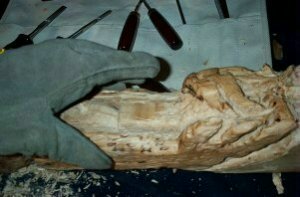 Lessons in Vigilance can be found just about everywhere--especially
when we make mistakes. They often come in the form of:
"I should've," "I wish I had," "If
only I had," "Why didn't I," and so on.
These are stabs. The work of Vigilance comes after
we say these things. Unfortunately, complacency usually
takes over and we don't correct our mistakes. We
repeat them instead until we give up trying.
Lessons in Vigilance can be found just about everywhere--especially
when we make mistakes. They often come in the form of:
"I should've," "I wish I had," "If
only I had," "Why didn't I," and so on.
These are stabs. The work of Vigilance comes after
we say these things. Unfortunately, complacency usually
takes over and we don't correct our mistakes. We
repeat them instead until we give up trying.
When I stabbed myself,
at least I knew I was going to do it, at some time in the future.
I had taken the "macho viewpoint," the one that says:
"I'm not a man if I don't bleed on the wood at sometime."
That was folly, of course. The pain in my left hand
is proof of it, and the fact I could have cut a tendon and rendered
my left hand useless or disabled would have been a severe price
for "machismo."
But I had the courage to
face my fear. I now wear a glove on my right hand.
I now stop before I start carving and ask the wood to keep me
patient, to remind me that we are one, the wood and I, and not
to allow me to forget the wood is my partner not something I
use to seek my end.
A Parent of Vigilance does
the same thing with a child. Before talking to the
child, the Parent of Vigilance takes a moment to get down to
eye level with the child. Even if that means climbing
out of the comfortable chair and sitting on the floor cross-legged.
It means the Parent of Vigilance realizes they are the Goliath
and the child a David. It requires Courage and Conviction
to take the extra effort to "be one with a child."
And, it requires Action to replace the Complacency of "talking
down" to a child.
A child is like a piece
of wood. Parents shape the child, carve its beauty
or mar its potential. As a grandparent I am more
aware than ever in my life about the importance of being "one"
with a child. As big as I am, and as hard as it
is for me to climb down onto the rug and get eye-level with
my grandchildren, I do my best to equalize myself with my grandchildren.
If I am going to add to the carving
of a child's magic, to his or her beauty, as I attempt to do
with the wood I am carving, I must respect the child's world,
just as I must respect the grains of the wood I carve, and let
my tools flow rather than shove and bully the wood.
The wound on my left hand is
a lesson, a lesson in Vigilance. The blood that
flowed were the Tears of Impatience, Neglect, Complacency.
I'm going to wear the Glove of
Vigilance, not only when I carve wood, but when I communicate
with my grandkids.
Semper Vigilantes--Always Vigilant.

Go
To Feb. 24--Vigilance Of The First Thought
©2001
- 2004, VigilanceVoice.com, All rights reserved - a ((HYYPE))
design
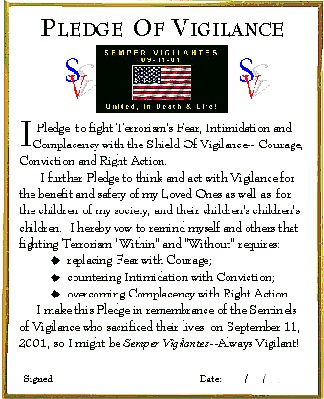
|
|


 They
were good for roughing out the wood, but the fine work, the
real carving of intricate hands or angles to reflect light seemed
beyond the scope of the chisel. I went to New York Art
Supply on 3rd Avenue, packed with real and would-be artists
of all sizes and shapes. I was looking for
more and better carving tools. They presented
me with a giant box filled with them. I was a kid in a
candy store. I bought one of each, scoopers, routers,
knife blades, groovers. I was elated.
They
were good for roughing out the wood, but the fine work, the
real carving of intricate hands or angles to reflect light seemed
beyond the scope of the chisel. I went to New York Art
Supply on 3rd Avenue, packed with real and would-be artists
of all sizes and shapes. I was looking for
more and better carving tools. They presented
me with a giant box filled with them. I was a kid in a
candy store. I bought one of each, scoopers, routers,
knife blades, groovers. I was elated. 
 Art of any form requires patience. When you
hurry, you rush Nature. And Mother Nature cannot be rushed. She works
at her own speed.
Art of any form requires patience. When you
hurry, you rush Nature. And Mother Nature cannot be rushed. She works
at her own speed.
 The ice numbed the pain. I come from the old school
where when the horse bucks you off you climb back on it and
ride again, to show the horse you're not afraid and to face
your fears. This time I used the tool with
respect, with patience, and even though drops of red oozed down
my hand from the ice, it felt good. I was learning
a lesson in wood carving Vigilance.
The ice numbed the pain. I come from the old school
where when the horse bucks you off you climb back on it and
ride again, to show the horse you're not afraid and to face
your fears. This time I used the tool with
respect, with patience, and even though drops of red oozed down
my hand from the ice, it felt good. I was learning
a lesson in wood carving Vigilance. Lessons in Vigilance can be found just about everywhere--especially
when we make mistakes. They often come in the form of:
"I should've," "I wish I had," "If
only I had," "Why didn't I," and so on.
These are stabs. The work of Vigilance comes after
we say these things. Unfortunately, complacency usually
takes over and we don't correct our mistakes. We
repeat them instead until we give up trying.
Lessons in Vigilance can be found just about everywhere--especially
when we make mistakes. They often come in the form of:
"I should've," "I wish I had," "If
only I had," "Why didn't I," and so on.
These are stabs. The work of Vigilance comes after
we say these things. Unfortunately, complacency usually
takes over and we don't correct our mistakes. We
repeat them instead until we give up trying.
